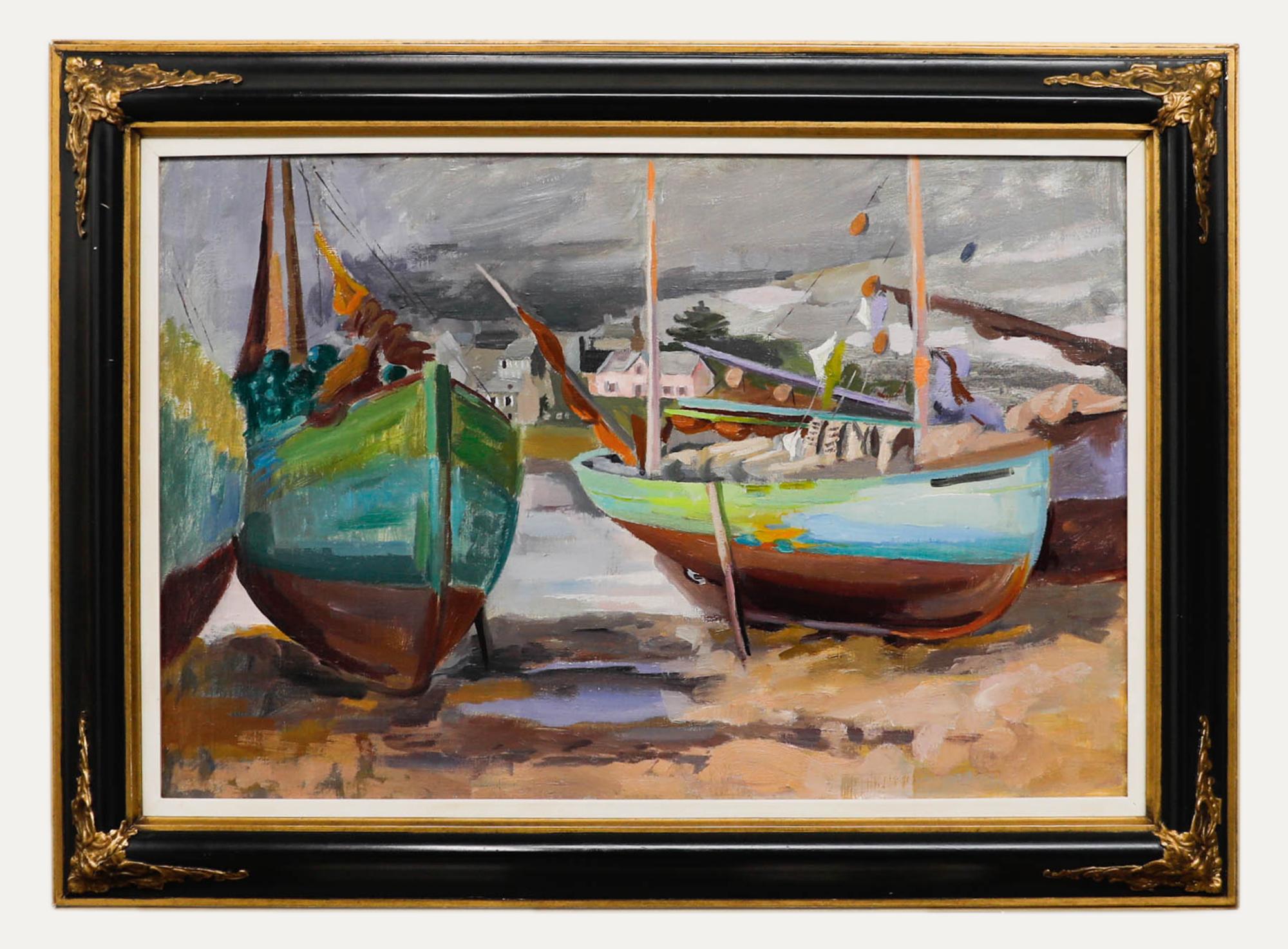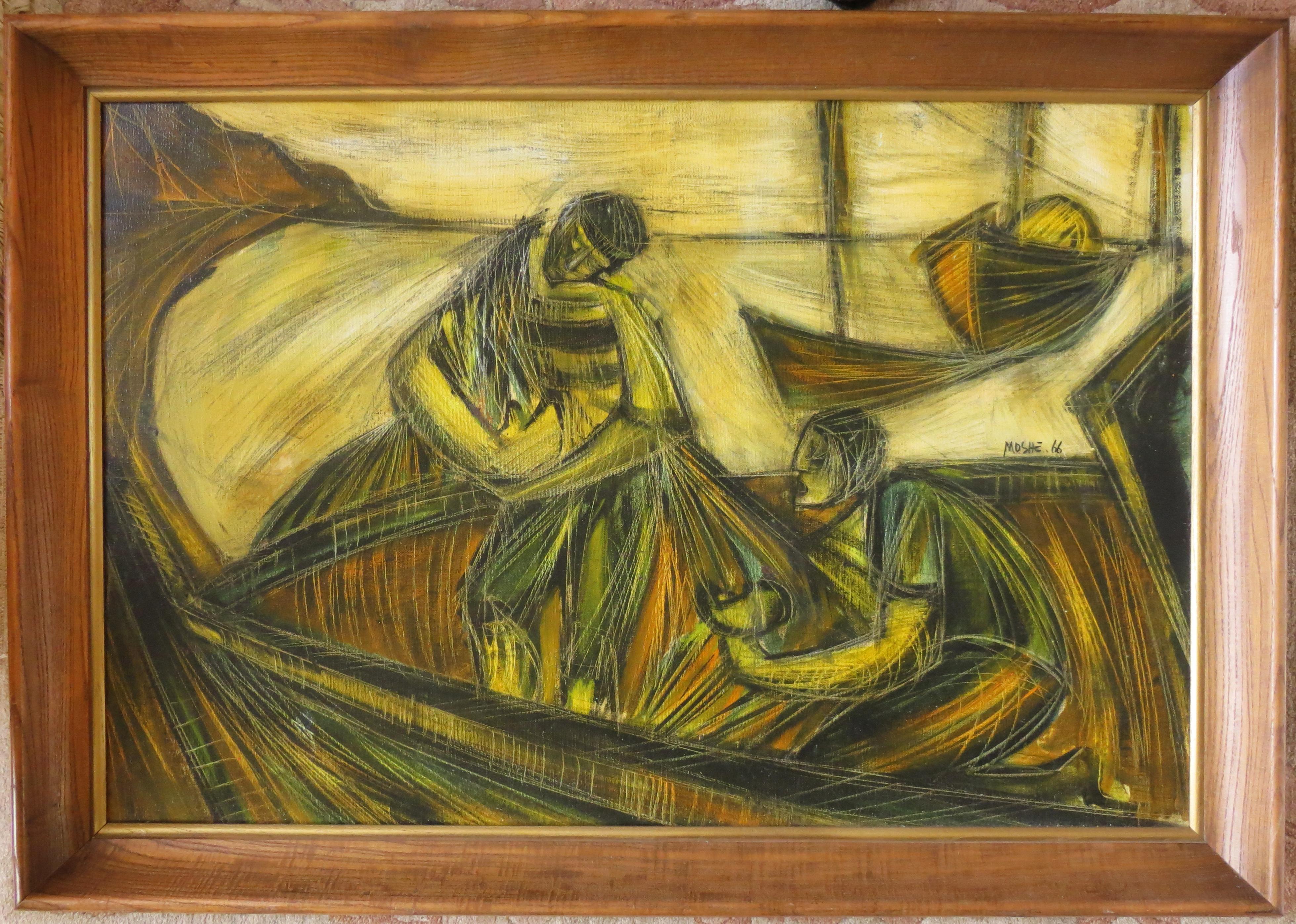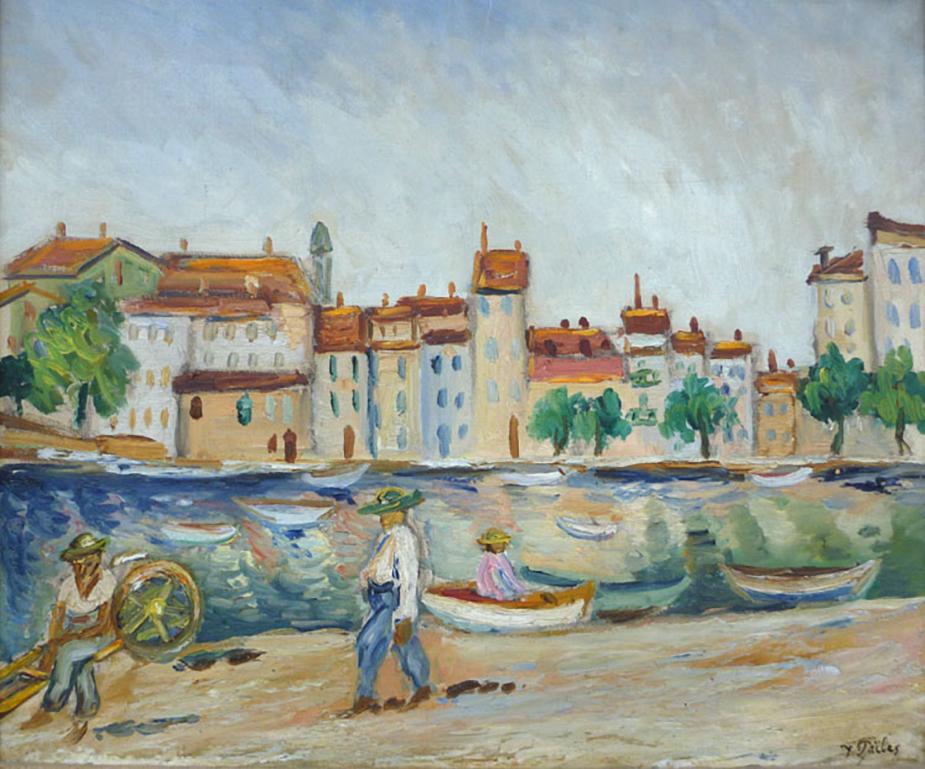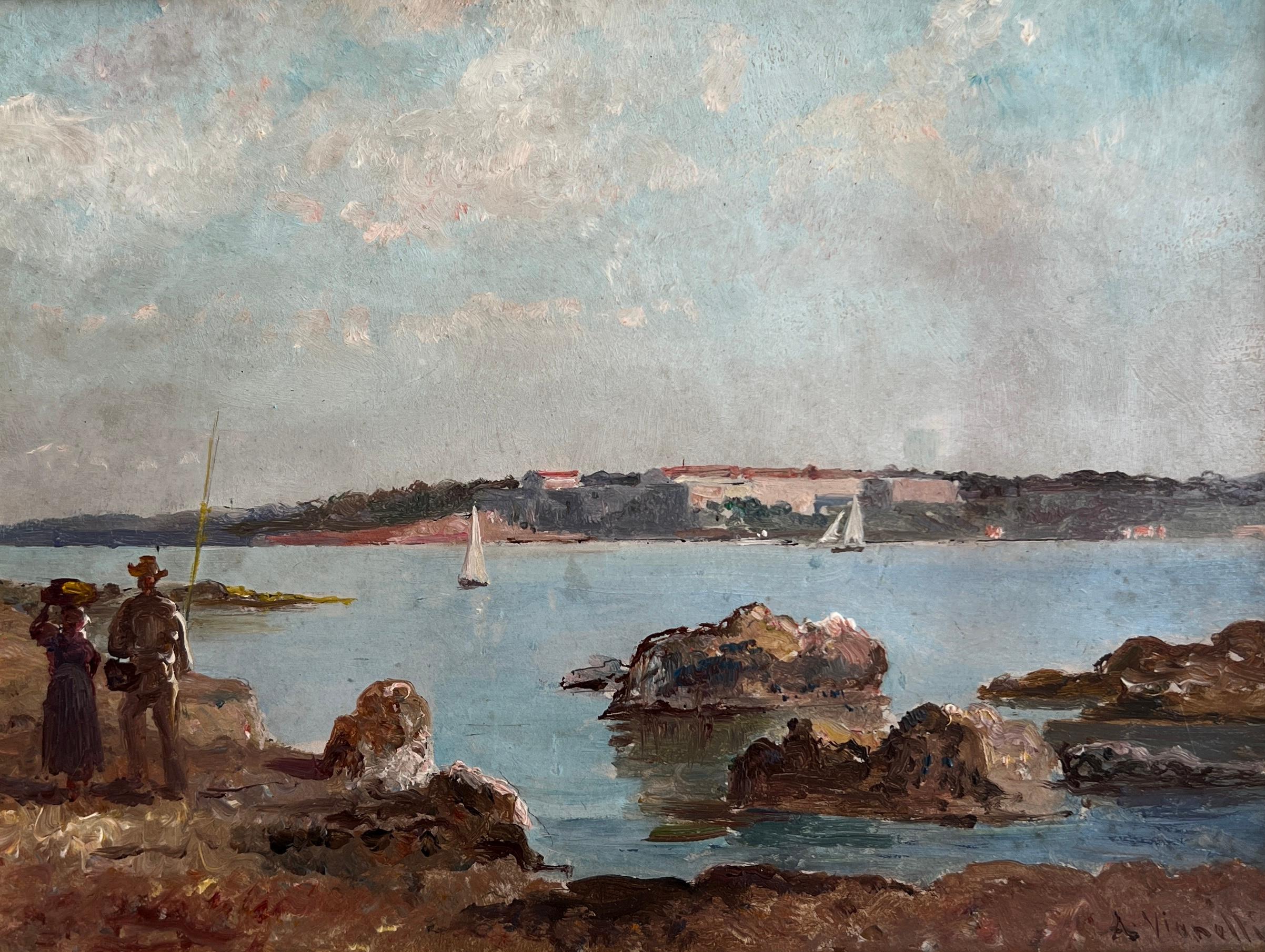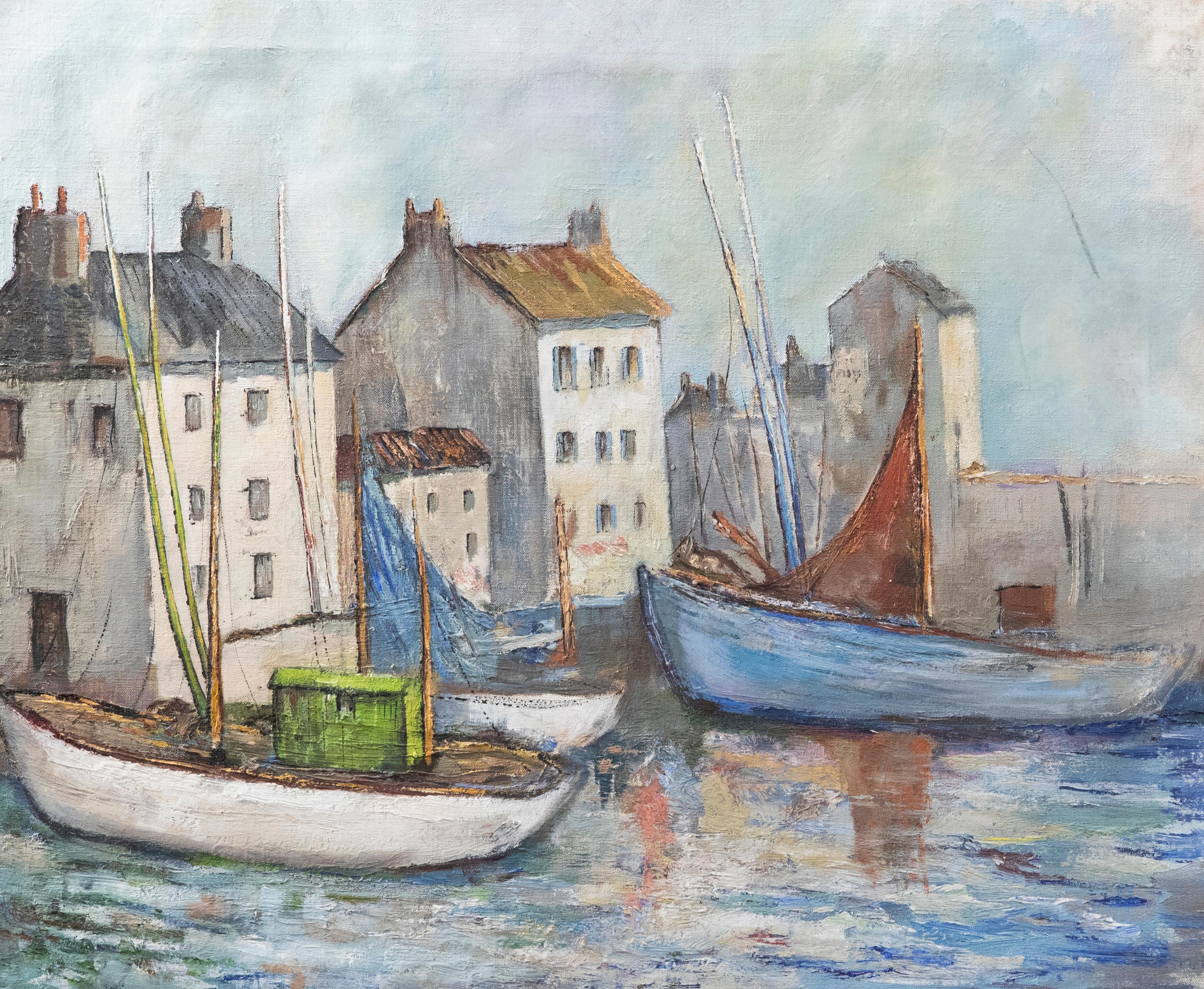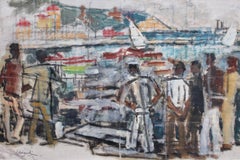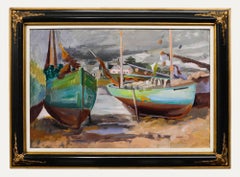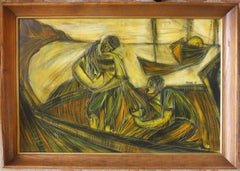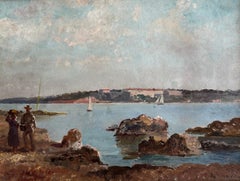Want more images or videos?
Request additional images or videos from the seller
1 of 20
Anna CostaThe Fishermencirca 1970s
circa 1970s
$2,755.63
£2,000
€2,351.92
CA$3,813.11
A$4,203.22
CHF 2,199.33
MX$51,572.21
NOK 27,685.15
SEK 25,889.99
DKK 17,556.41
About the Item
'The Fishermen', oil on canvas, by Anna Costa (circa 1970s). Cassis is a small, Provencal fishing village in southern France, located about 45 minutes east of Marseille and 45 minutes south of Aix-en-Provence. Known for its calanques (large rocky limestone coves), beaches, and beautiful port overlooked by a medieval chateau, Cassis isn’t exactly the image that comes to mind when you think of a typical town in Provence. But stepping into Cassis is like stepping into an impressionist painting, and nowhere is that more true than Cassis’ harbour, the Port de Cassis. In the 1960s and 70s, it was less popular for visitors than it is today. The artist's depiction here reveals a sleepy autumnal day in the port, the fishermen on the quay surveying the arrival of their workmate rowing in on a dinghy. Costa created this image using huge, audacious brushstrokes in both vibrant and muted colours. Overhead, the blue sky hosts large clouds nudged by Provence's northerly winds and the artist's brush. What is very clear is that Costa's artworks' charm springs from their naive simplicity and unassuming subjects.
Overall, the quality of light in Provence is one of the region's most distinctive features, and it has played a significant role in shaping the cultural and artistic identity of the area. The colours in Costa's artworks are famous for their richness and vibrancy, and the quality of light in the region plays a big part in this. Please enjoy the many photos accompanying the listing. It is in good overall condition commensurate with age and is newly framed with a French-style linen slip. Upon request a video will be provided. The stamp of the artist's atelier appears on the back side of the stretcher frame as is the case with the vast majority of her works.
About the Artist: Anna Costa (approx: 1922-2022) painted in her Provençal village in the Cavaillon area from the 1940s until the 1970s. Upon her passing, her estate released her art into the market where dealers around the world are clambering for her works. Costa's art is characterised by its bright colours and strong naive style which make them instantly recognisable. This style is called Provençal Colourism. It is a regional art movement that emerged in the South of France in the early 20th century. It is also characterised by bright and bold colours, as well as strong contracts between light and shadow. The movement drew inspiration from the natural beauty of the region including its landscapes, people and traditions.
Dimensions With Frame:
H 61.5 cm / 24.2"
W 76 cm / 39.9"
Dimensions without Frame:
H 49 cm / 19.3"
W 64 cm / 25.2"
Anna Costa (approx: 1922-2022) painted in her Provençal village in the Cavaillon area from the 1940s until the 1970s. Upon her passing, her estate released her art into the market where dealers around the world are clambering for her works. Costa's art is characterised by its bright colours and strong naive style which make them instantly recognisable. This style is called Provençal Colourism. It is a regional art movement that emerged in the South of France in the early 20th century. It is also characterised by bright and bold colours, as well as strong contracts between light and shadow. The movement drew inspiration from the natural beauty of the region including its landscapes, people and traditions.
About the Seller
5.0
Platinum Seller
Premium sellers with a 4.7+ rating and 24-hour response times
Established in 2016
1stDibs seller since 2017
536 sales on 1stDibs
Typical response time: <1 hour
- ShippingRetrieving quote...Shipping from: London, United Kingdom
- Return Policy
Authenticity Guarantee
In the unlikely event there’s an issue with an item’s authenticity, contact us within 1 year for a full refund. DetailsMoney-Back Guarantee
If your item is not as described, is damaged in transit, or does not arrive, contact us within 7 days for a full refund. Details24-Hour Cancellation
You have a 24-hour grace period in which to reconsider your purchase, with no questions asked.Vetted Professional Sellers
Our world-class sellers must adhere to strict standards for service and quality, maintaining the integrity of our listings.Price-Match Guarantee
If you find that a seller listed the same item for a lower price elsewhere, we’ll match it.Trusted Global Delivery
Our best-in-class carrier network provides specialized shipping options worldwide, including custom delivery.More From This Seller
View AllThe Fisherman
Located in London, GB
'The Fisherman', oil on board, by Gabriel Vié (circa 1940s). This artwork depicts a solitary man fishing in a river surrounded by abundant foliage. He is p...
Category
1940s Portrait Paintings
Materials
Oil, Board
Boats on a Pond
By Charles Kvapil
Located in London, GB
'Boats on a Pond', oil on canvas, by Charles Kvapil (circa 1930s). This tranquil artwork depicts people fishing from their small boats. The motionless pond is surrounded by lush foliage with some homes as backdrop. The painting is spattered with light. With hardly any air moving in the scene, the still water plays...
Category
1930s Landscape Paintings
Materials
Canvas, Oil
The Flea Market
By Catherine Garros
Located in London, GB
'The Flea Market', oil on canvas, by Catherine Garros (circa 1990s). The viewer can feel the light of the French Riviera shine through this seductive ...
Category
1990s Figurative Paintings
Materials
Canvas, Oil
Sailors in the Port of Nice
By Alfred Salvignol
Located in London, GB
'Sailors in the Port of Nice', mixed media - gouache, pastel and oil on paper, by Alfred Salvignol (circa 1950s). The Port of Nice is one of the key hubs of Nice and, in fact, of the entire French Riviera, standing out as one of the main harbours for the boats which sail across the Mediterranean Sea. It accommodates both the ships operated by ferry companies and the private yachts of visitors who come to Nice by sea. The artist here depicts a group of crusty sailors watching...
Category
1950s Expressionist Mixed Media
Materials
Paper, Pastel, Oil, Gouache
Portrait of a Young Woman
Located in London, GB
'Portrait of a Young Woman', oil on board, by Anna Costa (circa 1960s). This is a beautiful, expressive portrait of a young woman painted by the artist using her trademark vibrant c...
Category
1960s Modern Portrait Paintings
Materials
Oil, Board
Landscape
By Charles Kvapil
Located in London, GB
'Landscape', oil on canvas, by Charles Kvapil (1928). The artist, Kvapil, has scores of tremendous artworks which depict scenes in nature such as this one. Here, a bit of Mediterrane...
Category
1920s Expressionist Landscape Paintings
Materials
Canvas, Oil
You May Also Like
20th Century Oil - fishing Harbour
Located in Corsham, GB
Unsigned. Presented in a black frame with gilt detailing. On canvas.
Category
20th Century Figurative Paintings
Materials
Oil
$510 Sale Price
20% Off
Untitled - Fisherfolk
By Moshe Katz
Located in San Francisco, CA
Artist: Moshe Katz – Romanian/Israeli (1937-)
Title: Untitled - Fisherfolk
Year: 1966
Medium: Oil on canvas
Size: 24 x 36 inches
Framed size: 28.5 x 40.5 inches
Signature: Signed, d...
Category
1960s Modern Abstract Paintings
Materials
Canvas, Oil
Fishermen - Russian French
Located in London, GB
This oil painting is signed by the artist "I Pailes" at the lower right corner.
The work was painted in circa 1930's.
Provenance: The Issachar Ber Frydman collection.
Acquired in F...
Category
1930s Landscape Paintings
Materials
Canvas, Oil
Fishermen
Located in Genève, GE
Work on cardboard
Plaster frame and gilded molded wood
34.5 x 40 x 4 cm
Category
Early 20th Century Italian School Landscape Paintings
Materials
Oil
20th Century Oil - Harbour Scene
Located in Corsham, GB
An impressionistic harbour scene in oil, complete with fine black outlining to the sea-side houses and fishing boats. A second artwork can be seen to the reverse of the oil,- A Still...
Category
20th Century Figurative Paintings
Materials
Oil
$487 Sale Price
20% Off
Fishermen by the Boats - Maritime Seaside Coastal
By Mane Katz
Located in London, GB
MANE KATZ [Katz Emmanuel] 1894-1962
Kremenchug, Ukraine 1894-1962 Tel Aviv (Russian / Ukrainian / French / Israeli)
Title: Fishermen by the Boats, circa 1941
Techinique: Original Signed Oil Painting on Canvas
Size: 51 x 61 cm / 20.1 x 24 in
Additional Information: The work is signed "Mane Katz" on the right hand side.
This work was painted circa 1941.
Provenance:
Graham Gallery...
Category
1940s Expressionist Paintings
Materials
Oil
More Ways To Browse
Anna Costa
Anna Costa Paintings
European Bob
Girl With Dog
Peasant Woman
Elephant Painting Canvas
Harlequins Paintings
Marthas Vineyard Vintage
Hawaiian Glass
Camel Art
Madeleine Paris
Norman West
Oleg Artist
Cubist Face Painting
Krishna Painting
New England Folk Art Painting
Painting Orthodox Church
Paintings Of Chess
